Media | Articles
1973–87 Chevrolet/GMC Truck buyers guide
Whether Chevrolet or GMC, the General’s third-generation, “square-body” trucks were a dramatic departure from the company’s previous efforts. The third-gen models featured squared-off front and rear fascias, subtle body contours honed by wind-tunnel testing, a more accommodating and ergonomic interior, and even an available crew-cab body, a style decades ahead of its time.
With that in mind, what follows is a quick, high-level overview of the third-generation C/K truck—be it two-wheel-drive C10/C20/C30, or four-wheel-drive K10/K20. We’ll take a look at model differences year by year but also highlight special editions, so you’ll know which examples are best for you!
1973

The 1973 square body trucks were new from bumper to bumper, with a tougher look than either Dodge’s new, rounder D-series (1972–1980) or the sixth-generation (1973–1979) Ford F-series. But the General’s trucks also benefited from modern computer simulations, long before production, in the interest of increased durability. While the ’73 design was indeed squarish, as the name suggests, it saw wind-tunnel time during development in order to improve aerodynamics and lower side air turbulence: corners were rounded, side windows were curved, the body sides featured prominent curves from front to back, and the tail lights wrapped around the bed. The angular wheel arches were rounded at both corners to help take the edge off the styling, and compared with its predecessor, the truck featured a radical increase in glass area.
Wheelbases on the all-new frame grew from 1972: Short-bed models (six and a half feet of bed length) saw a 2.5-inch bump, to 117.5 inches, and long-bed models (eight feet of bed) gained 4.5 inches, to 131.5. A new Crew Cab option, with two rows of passenger seating, was available for the one-ton trucks, while a “Big Dooley” option gave the square body two pairs of rear wheels for heavy loads. Both Chevrolet and GMC models were available in either a smooth fleetside bed or a stepside one, and wood bed floors with steel skid strips were optional. Fleetside bodies had optional lockable tool compartments on the bottom of the bed.
Engine options were plentiful. Buyers could choose from a 250-cubic-inch in-line six (100 hp), a 292-cube six (120 hp), a 307 V-8(115 or 130 hp), a 350 V-8(155 hp), and the all-new, range-topping 454 big-block V-8 (240 hp). Three- and four-speed manual transmissions were available, plus a three-speed Turbo Hydramatic automatic. Power steering and power brakes were optional.
Marketplace
Buy and sell classics with confidence
The square body also gained an all-new interior. The standard wraparound dashboard sported a full complement of gauges. Air-conditioning was available, and buyers could option in an AM or an AM/FM radio, either of which had its antenna cleverly integrated into the windshield. Chevy/GMC offered similar trim levels—Custom, Custom Deluxe/Super Custom (code Z62, with more exterior chrome, chrome wheel covers, and interior features like a dome light, a cigarette lighter, and wood trim), Cheyenne/Sierra (code Z84, with more wood trim, extra insulation, upgraded door panels, etc.), and a Cheyenne Super/Sierra Grande trim level (code YE9, with even more wood trim, thicker carpeting, richer seat fabrics, and optional bucket seating with a center console). Higher trim levels featured bright trim around the body’s side curves, that trim often delineating a two-tone paint treatment.

The new frame allowed for a lower cab, which aided in entry and exit. Front spring rates were newly softened, and a front anti-roll bar, a new feature, helped improve both ride and handling. Front disc brakes were also standard. Rear leaf springs were now two-stage progressive, while rear shock mounts were redesigned in order to reduce wheel hop. An energy-absorbing steering column was added to the cab, and the arrival of GM’s infamous “side saddle” fuel tank saw the truck’s fuel move from from inside its cab to outside its frame rails. (That tank design was later featured on Dateline NBC, where the show’s producers rigged a crash test to ensure that a square-body tester would catch fire following an impact. The episode resulted in long court debate and an extraordinary public apology by NBC.)
For fans of the outdoors, a camper-special square-body model was aimed at heavier, bulkier loads, and it featured the amusingly named Elimi-Pitch Package. The latter included special dampers connecting bed to body and camper to cab, to help calm the truck’s handling in turns. With so much new to offer, is it any surprise that 666,619 C/K trucks were sold this year by Chevrolet? (At press time, GMC sales figures were unavailable.)
1974

The square body’s second year brought modest changes: optional rain gutters above the doors, and the 307 was axed in favor of another 350 V-8 (145 hp) with a two-barrel carburetor. A new full-time four-wheel-drive system was available—albeit only on V-8 models—thanks to a new NP203 transfer case.
1975

A bolder grille greeted buyers this year, with Chevy’s traditional egg-crate center no longer sunken inside an outer chrome shell. This was the last year that the truck’s grille wore an emblem indicating engine displacement, but behind it sat GM’s new HEI ignition, plus a slew of new intake and emissions equipment, including catalytic converters, if a truck’s equipped GWVR fell under 6001 pounds. The 250-cubic-inch inline six engine now made 105 hp. Models over that 6001-pound GVWR could be ordered with a new, 175-hp, 400-cubic-inch V-8.
For those seeking more utility from a half-ton (C10), or a legal way to avoid complex emissions equipment, Chevy/GMC created the BIG 10/Heavy Half (F44) and placed that name on the trailing edge of the bed. With a GVWR slightly above the emissions threshold (6050 pounds), these trucks offered more performance and lower fleet-management costs (leaded fuel was cheaper and still plentiful) at the expense of more emissions.
Four trim levels were still offered, but both Chevrolet and GMC opted to rename their offerings: Custom Deluxe/Sierra, Scottsdale/Sierra Grande, Cheyenne/High Sierra, and the top-line Silverado/Sierra Classic.
1976

Changes were minimal. Rally wheels appeared, and a new Sport model was available on Scottsdale trucks equipped with a stepside bed. Sports paired the aforementioned rally wheels with white-letter tires and color coordinated custom graphics.
Replicating the successes elsewhere in Chevrolet’s lineup, a new Bonanza special-equipment package was also available on Scottsdales. Bonanzas came with numerous trim and option upgrades in four levels: YG6, YG7, YG8, and YG9.
1977
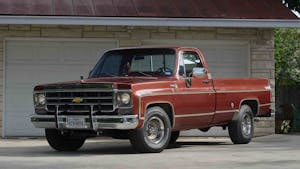
A new grille with more prominent horizontal lines greeted buyers, and the square body’s chrome side trim now featured a gold stripe inside its central channel. In-cabin hood releases became optional, along with power windows, power door locks, a rear window defroster, and intermittent wipers.
Fleetside models now offered the stepside’s Sport trim package, but only for short-bed configurations. Trucks ordered with bucket seats saw a switch from low-back seats to high-back units, while the 3+3 crew-cab configuration was now available with a rear-seat delete. The change gave an extra 56 cubic feet of storage space in the cab and protected from the elements.
A new 305 V-8 with a two-barrel carburetor replaced the entry level 350, producing a reasonable 145 hp.
1978

For buyers of GM’s half-ton and two-wheel-drive trucks, 1978 brought an all-new diesel V-8 (LF9) producing 120 hp, and more important, 220 lb-ft of torque. This was the Oldsmobile 350 diesel, notorious for head-bolt issues. (If you’re looking for one now, a diesel square body that hasn’t been converted to another V-8 is a rare find indeed.)
The inclusion of a catalytic converter for models sold in California required modest frame changes. Both Cheyenne and Silverado trim levels received new aluminum-style interior trim instead of wood grain: The Cheyenne used a diamond pattern (dashboard only, aluminum everywhere else) while the Silverado featured brushed aluminum around the gauges, above the glove box, and on the inner door panels.
Like the 1976 Chevrolet Sport package, the special-edition GMC Street Coupe, launched this year, came in eye-catching colors, with aluminum wheels with white-letter tires and a custom hood ornament. The model was produced until 1980.
1979

Changes were modest this year—notably a new grille shell that integrated the headlights and turn signals, and a new hood with a raised, plateau-shaped stamping above the grille.
From this point on, catalytic converters were made standard on all models with a GVWR of less than 8,500 pounds.
1980

While GM’s 1980 sales brochure showcased the C/K trucks’ new square-headlight fascia, the look was limited to top-line Silverado models; round-headlight C/Ks were far more common and remain so today. 1980 also brought a more prominent egg-crate grille and new side-view mirrors, while the deletion of the NP203 transfer case meant the four-wheel-drive system on offer was part-time only.
Square-body trucks also gained the rather carlike options of an AM/FM 8-track radio, an AM/FM cassette player, or an AM/FM/CB radio.
1981

Changes included a new fascia with a sleeker grille integrating two square headlights (four lights with halogen high beams for the Deluxe Front Appearance Package), new bumpers and a new tailgate, revised two-tone paint designs, a more ergonomic dashboard, new seats, and a weight reduction of up to 300 pounds, depending on configuration.
Functional changes were numerous: relocated fuel tank (driver’s side); a low-drag fan clutch; more efficient radiators; radial tires (for C/K 10s and 20s); disc brakes with lower drag; revised rear springs with a lighter, semi-floating axle; new automatic-transmission clutches; quieter exhaust systems; and a lighter battery.
Engine choices included a new 305-cubic-inch V-8 with electronic spark control (49-state only), while the 400-cube V-8 was removed from availability. An new transfer case, the NP208, appeared on K10 and K20 trucks, and all K-series models received automatically locking front hubs and quad front shocks.
1982

The mid-level Cheyenne trim level was deleted. Powertrain changes were significant: the two-barrel, 305 was discontinued, while the Olds 350 diesel was replaced by an all-new, highly regarded 6.2-liter diesel (130 hp, 240 lb-ft) with a three-speed automatic. Diesel models wore prominent “6.2L” badging on the tailgate, a foreshadowing of things to come—the metric system was inbound on American trucks.
A new four-speed (Turbo Hydramatic 700R4) automatic sported a fuel-saving overdrive gear and was available on either of the two small-block V-8s offered, 305 or 350. The transfer case on K30 trucks was now synchronized, allowing activation at up to 25 mph, while power steering was made standard for all K-series models. The heavier duty 20- and 30-series trucks now rode on standard 16-inch wheels.
1983

A new grille once again greeted buyers, its insert either silver or body color. Large signal lights also appeared below the headlights this year. (If a truck was equipped with the Deluxe Front Appearance Package, which brought quad headlights, the signal lights were mounted within the grille.)
1984
Changes were minimal this year—metallic brake pads (front) for 10- and 20- series models, new plastic shields for the side-saddle fuel tanks, and a new steering-column stalk lifted from other GM products.
1985
The grille texture changed slightly, a rear cargo light was added, and GM’s new, 4.3-liter V-6 (155 hp) replaced the entry level 250-cube six-cylinder. There were now four unique designs for customers interested in two-tone paint: conventional, special, deluxe, and custom.
1986
No significant changes for the square body.
1987
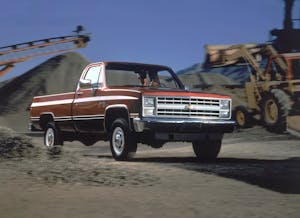
The biggest news for the square body’s final production year was the introduction of computerized, throttle-body fuel-injection on 4.3-, 5.0-, 5.7-, and 7.4-liter gasoline engines. The tried and true 292-cubic-inch six was no longer available on 30-series trucks, replaced by the 10-series’ optional 5.7-liter. The C-designation (two wheel-drive, remember) was renamed to R. K (four-wheel drive) turned into V, but remained with 10, 20, and 30 series designations. This was also the last year for the name “stepside”, as that bed was renamed “sportside.”
Special Editions
1974
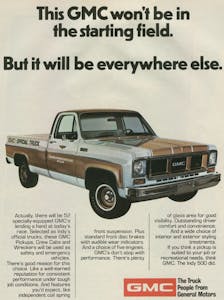
GMC was the official truck for the Indianapolis 500, and 1000 replicas were finished in a white/gold color scheme, similar to the 1974 Hurst/Olds pace car.
1975
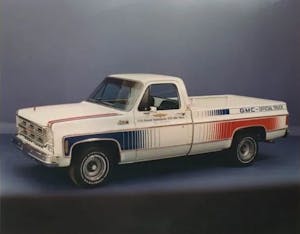
GMC again paced the Indianapolis 500, with commemorative replicas wearing red and blue gradient graphics on a white short-bed body.
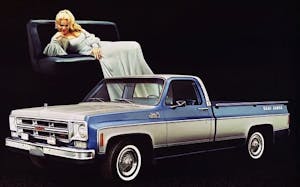
The GMC Beau James was a top line Sierra Classic with a blue/silver paint scheme, whitewall tires, “wire-wheel” wheel covers, “Beau James” graphics at the end of the bed, and even a hood ornament with the Beau James logo!

The GMC Gentleman Jim added a sporting twist to the Beau James, with rally wheels, white-letter tires, vinyl bucket seats (with console), “Gentleman Jim” graphics at the end of the bed, and a black/gold paint scheme worthy of the Bandit’s Trans Am.
1976
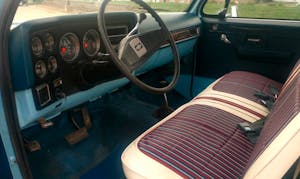
Based on the Chevy Scottsdale Bonanza, the Spirit of ’76 celebrated America’s bicentennial, with a red/white/blue cloth interior, “Spirit of ’76” door emblems, floor mats featuring an eagle motif, and full wheel covers with whitewall tires. Paint was either blue/white or light blue with geometric red/white/blue body decals.
Canadians weren’t left out in the cold, as GMC offered an Olympic Edition based on the Sierra Grande—a white/red paint job, rally wheels, and a hood ornament with the five-rings Olympics logo.

GMC was again the Indianapolis 500 Pace Truck, and this year had an animated Eagle decal on the bodysides and, in Pontiac Trans Am fashion, a stylized eagle on the hood.

Lastly there was the Impact ’76, a GMC finished in white with red and blue gradient graphics similar to the 1975 Indy 500 Pace Truck. The key differentiator for the Impact ’76 were the exterior styling accessories (air dam, roof air deflector, mud flaps) from the Motortown Corporation for this special edition.
1977

GMC was once again the pace truck for the Indy 500, this time with a novel black-to-white fade scheme on the truck’s center, through gray gradient stripes. The front bumper sported a sleek air dam, and the color treatment carried over to the white wagon-wheel wheel spokes.

GMC also partnered with Hickey Enterprises to make the Desert Fox. The Fox featured one of the most memorable graphic treatments in the division’s history—a cornucopia of earth-tone stripes laid over a buckskin-colored body. The front guard, roll bar, and wagon-wheel spokes were also painted buckskin. Unsurprisingly, the model has a cult following in the Middle East—the connection was enough for GMC to make a Desert Fox tribute truck in 2017.
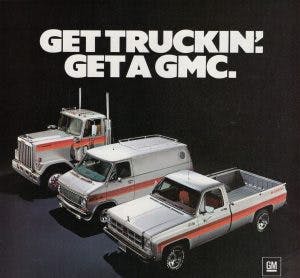
Sharing the spotlight with GMC big rigs and vans but limited to C/K 20 configurations, the 1977 Sarge model featured forged aluminum wheels, white-letter tires, silver paint with red/orange/yellow stripes, color-matched bed rails, a three-spoke steering wheel wrapped in leather, and a CB radio.
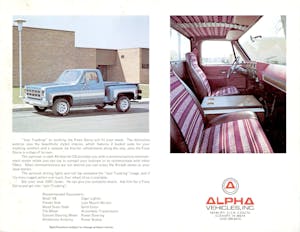
And then there’s the Foxy Sierra. While the exact production year remain unclear, the grille pictured here suggests the GMC Foxy Sierra was created in 1977. The model offered white/gray graphics over numerous color choices, plus a restyled interior with unique upholstery and a floor console that doubled as an ice chest.
1978

Chevrolet once again had the Indy 500 Pace Truck this year, but its war paint looked nothing like the custom package gracing the division’s Corvette pace car. The model saw a radical red/white paint job, commemorative lettering in a bold font, a sleek lower valence, color-matched aluminum wheels, and white-letter tires.
1979

The GMC Amarillo series by American Coach Corporation was a three-tier upgrade, starting with a cosmetic red/orange/yellow stripe treatment. The GT package added an aerodynamic body kit, a tonneau cover, 10-inch-wide turbine wheels with white letter tires, side exhaust pipes, and a leather-wrapped steering wheel. The top-level Cowboy Cadillac featured everything from the GT but added upgrades worthy of the name: fabric-wrapped panels, 32-ounce carpet and matching floor mats, a high-back “Trucker’s Lounge” seat, and Delco’s top-of-the-line 8-track audio system. With a 454-cubic-inch-V-8 under the hood, performance bettered that of Dodge’s Lil’ Red Express in magazine tests, likely due to the aftermarket wheel/tire combo.
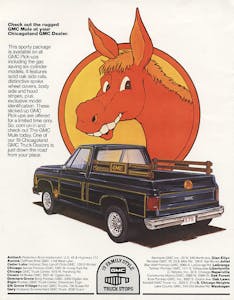
The GMC Mule was a take on Dodge’s Warlock truck, complete with black paint and gold accents, stake bed planks wearing the original GMC logo, and decals featuring a cartoonish mule rendering.
1980
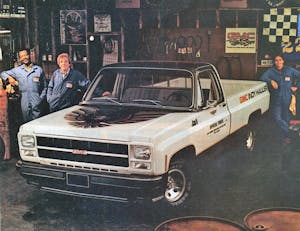
Mimicking the Pontiac Trans Am Indy Pace Car, the GMC Pace Truck wore a black/white/gray paint scheme, with the black cab morphing into the Firebird’s trademark “screaming chicken” hood decal. Forged aluminum wheels with white-letter tires were included, while chrome bumpers/mirrors/grille were instead painted black or white to match the adjacent body panels. A custom front bumper valence was also installed, painted black to match.
1981
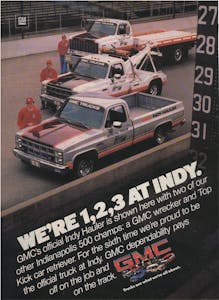
The 1981 GMC Indy pace truck replicated the silver/red theme of Buick’s Regal Indy Pace Car. Graphics were far more subtle over the previous year’s pace truck, and items you would expect to be chrome—bumpers, mirrors—were indeed left unpainted.
1983
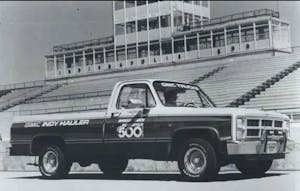
The GMC pace truck for this year had a more subtle cream, red, and brown paint scheme, to complement the elegant Buick Riviera pace car. Chrome parts remained untouched, while rally wheels and white-letter tires rounded off the package.
1984
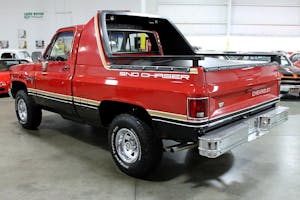
Presumably only offered in K-series four-wheel drive, the Chevrolet Sno Chaser was advertised as a stylish way to travel in winter climates. There was a unique spoiler that visually extended the B-pillar. Sno Chasers were offered in a red/black paint job with gold graphics, and came with white painted wagon wheels.
1985
The Chevrolet Outdoorsman was a special package that offered unique Green, Gray, Blue, or Gold colors with an Outdoorsman decal set, plus your choice of $500 worth of of name-brand hunting, camping or fishing equipment. The hunting package included a Winchester Model 94 XTR hunting rifle with a Chevrolet Outdoorsman emblem recessed into the stock, while Outdoorsman TV commercials featured NFL player Dick Butkus.
1986

The Indy 500 pace truck was painted to match the yellow Corvette pace car, complete with black letterings, forged aluminum wheels, and a monochrome paint treatment.
1987
Offered to GMC truck buyers in California, the California Sundancer was, as its name suggests, a regional special available only in Southern California. Sundancers were painted yellow over charcoal gray, with a gray body stripe and charcoal-colored tube bumpers.
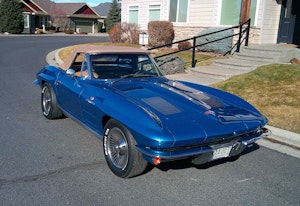
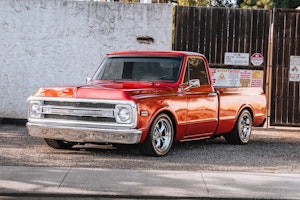
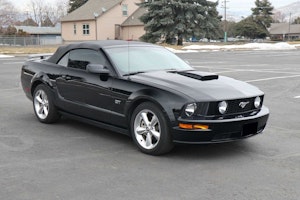

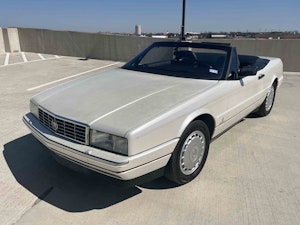







I have a 1973 Chevy c10 pickup. Model #cc10903 option# z84 custom sport truck with yg2 wood grain
was a wooden bed floor an option on a 1980 chevy pickup
tengo una chevrolet c 10 año 1984. gracias
The story here, left out some of the options on factory lifted 4×4 3/4 and 1-ton pickups.
73-87 Chev / GMC trucks !
Great article and interesting read
They really produced some cool rides
Too bad some models were only available in the USA